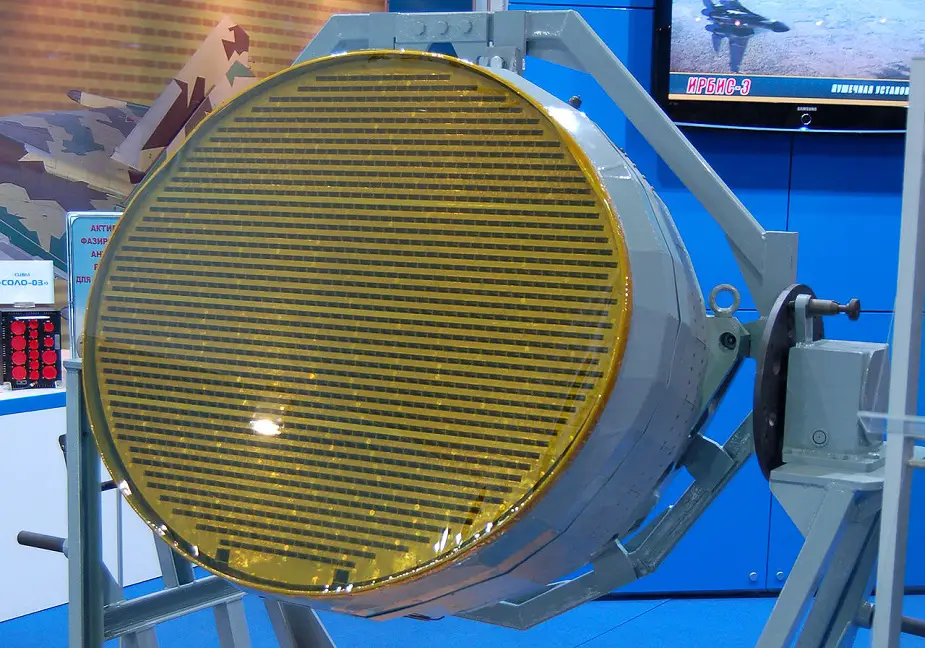Breaking news
Su-57 radar design to be used in new onboard equipment.
Fifth-generation fighter jets are distinguished by a radar with an active phased or active electronically scanned array (AESA). Only several countries in the world can produce such radars. The latest Russian Su-57 fighter jet carries Belka radar with several active phased antenna arrays to provide a maximum view of the airspace, Rostec said.
Follow Air Recognition on Google News at this link
 Sukhoi Su-57 stealth fighter aircraft showcased during MAKS-2019 (Picture source: Air Recognition)
Sukhoi Su-57 stealth fighter aircraft showcased during MAKS-2019 (Picture source: Air Recognition)
Mechanical scanning of the antenna beam was used to search for targets at the initial stage of radar development. Antennas then appeared with an electronically scanned beam (E-beam) or the so-called passive electronically scanned array (PESA).
They are divided into numerous emitting cells that create an array. Each cell has a phase shifter. A special device regulates phase delay individually in each cell to direct the antenna beam to the assigned point. E-beam radars can immediately redirect the beam in any direction and thus enjoy better target detection and tracking than radars with mechanical scanning.
The first PESA were designed for the military in 1960s. The bulky radars were installed on big stationary facilities and demanded numerous additional devices. Radars for warships appeared later. The first PESA-equipped jet in the world was MiG-31 with Zaslon radar. It was designed by the Tikhomirov Instrument-Manufacturing Institute. Almaz-Antey and Radio-Electronic Technologies (KRET) Companies are the stakeholders.
Mechanical and electronically scanned passive radars have the same design: antenna-transmitter-receiver. The main drawback is that the breakdown of the transmitter strips the aircraft of the possibility to monitor the airspace. The new generation of radars with active electronically scanned arrays (AESA) rectifies the problem.
The main AESA difference from PESA is that each cell has an active receiver-transmitter controlled from a single electronic center. AESA redistributes the general radar functions between numerous modules, which can number a hundred and a thousand. The destruction of several dozen modules is not critical for AESA, as the remaining modules continue to operate.
AESA is distinguished by reliability and effectiveness, simple operation, small weight and size, and ability to simultaneously operate in several frequencies. Its drawback is a high cost of design and production. It will decrease as technologies develop.
The first serial Belka AESA radars for the Russian fifth-generation Su-57 fighter jet were produced by the Ryazan Instrument-Manufacturing Plant. The radars were designed by the Tikhomirov Institute and the array by Istok Company. Belka is currently supplied in the onboard electronic equipment of Su-57.
The fighter jet has a set of antennas distributed in the aircraft. The complex unites several AESA of the X band in the nose and two side-view arrays, as well as two L-band AESA in wing edges. Belka is made of completely Russian components on the basis of heteronanostructures of gallium arsenide (GaAs) and advanced technologies of E-beam antennas.
Belka will be used to design AESA equipment for other aircraft and for ground use.
 Byelka AESA radar for the Su-57 on display at the 2009 MAKS airshow (Picture source: Allocer)
Byelka AESA radar for the Su-57 on display at the 2009 MAKS airshow (Picture source: Allocer)
© Copyright 2021 TASS. All rights reserved. This material may not be published, broadcast, rewritten or redistributed.


























